Part of the terrace built by Daniel McNicol around 1865, in a street that was was originally to be called Annita Place. The house was first numbered as 35 Regent Park Square, but renumbered as 31 in 1929-30.
Alexander Brown McLachlan
Alexander was a son of Artt McLachlan, a portioner and publican from Luing, who ran his wine and spirit business initially from 72 Great Clyde Street, and from 1856 at 99-101 Great Clyde Street, in Glasgow. The latter property was just to the west of the Custom House and was known as the Custom House Vaults. While one son went to sea and another became a medical student, three of the boys, including Alexander, worked with their father in the wine & spirit business at Great Clyde Street.
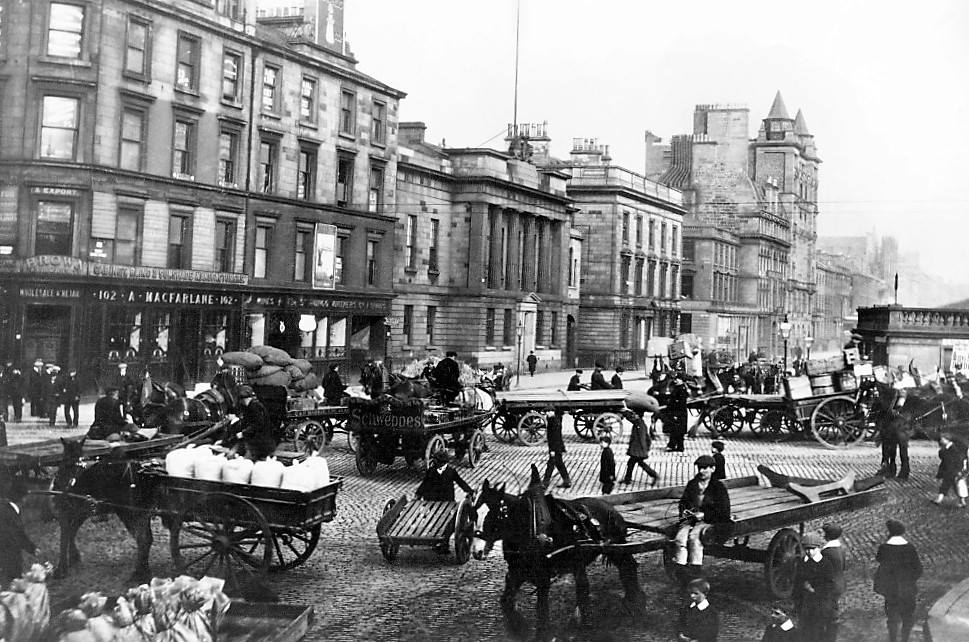
The Custom House Vaults of Artt McLachlan, in later guise as St Mungo’s Vintners (between MacFarlane’s and the Custom House). Source: Glasgow City Archives
Alexander (often “A. B.”) married Mary Agnes Fletcher in 1864 just down the road from the vaults at St Andrews RC Chapel (now the Roman Catholic Cathedral) and in 1865 the couple moved to 35 Regent Park Square. That November Mary gave birth to a son, Artt, but he died after only a few weeks. The couple soon left, and Alexander himself then died of a prolonged pneumonia in May 1866 at 3 Apsley Place in the Gorbals. He was just 33.
Artt Senior continued to live at Great Clyde Street, although he was retired by 1871, his other sons continuing the business. According to Old Glasgow Pubs, the business was sold in 1881 and became St Mungo’s Vintners, although the McLachlans may have retained ownership of the building; son Duncan worked for a while as a house factor but was back living there in 1901. Vintners survived to the 1990s, but the building has now been demolished .
In the 1866 PO Directory the occupant was a Mrs Michael Fletcher, but no other information is provided. I suspect she was Alexander’s mother-in-law, Rosanna/Rose Ann Fletcher, nee Braceland. However she died in 1867 and the house in Regent Park Square was given up.
The tragic life of Mrs McLachlan
Spare a thought however for Alexander’s poor wife, Mary Agnes Fletcher. She lost her father in 1863, her infant son in 1865, her husband in 1866, her mother in 1867, her brother Joseph in 1870 aged just 19, and her second husband in 1873. She lost another brother Andrew Scott Fletcher, a writer (solicitor) who absconded on a charge of fraud for which his co-conspirators were sent to prison. He was outlawed and “put to the horn” but disappeared from the record thereafter, his fate unknown . The only family she had left was one brother, Patrick, who worked at a booksellers.
Ever hopeful, she married a third time to Angus MacGregor in 1876 and eventually had a family; a daughter born in Northern Ireland and a son in Minnesota. You can’t blame her for wanting to leave Glasgow behind for somewhere new. However she died in Portland, Oregon in 1888 aged only 47, her son a mere 5 years old. Her husband fared better, outliving her by 43 years, but also outliving both their children. Somewhat appropriately, he managed a cemetery in Portland.
William Aristides Vérel
The next occupants were the Vérels, a fascinating French-Scottish family.

William Vérel. Source: ChristopherTW, Ancestry
William Aristides Vérel was born in Caen, Normandy in 1824 to Francois Masin Vérel, a lace manufacturer, and Marie Anne Anthoius. By 1841 he had come to Britain and was living with The Rev William Mester, a well-travelled graduate of Marischal College in Aberdeen. Mester’s wife Julie was probably Marie Anne’s sister, and hence Vérel’s aunt. Mester was a teacher of languages in Aberdeen .
In 1849 William married Ann Bisset in Aberdeen and they settled initially in Gamrie, Banffshire. By 1855 William & Ann Vérel were in Macduff, Banffshire and William had filed a patent for “improvements in grinding or pulverising bones”. He became the general manager of MacDuff Commercial Company and in 1858 was advertising a wide range of agricultural products including Vérel’s bone and horn powders. They had five sons and a daughter. In 1861 William Mester was also living with them. Mester died in 1864 and, having no children of his own, left his money to the Vérel children.
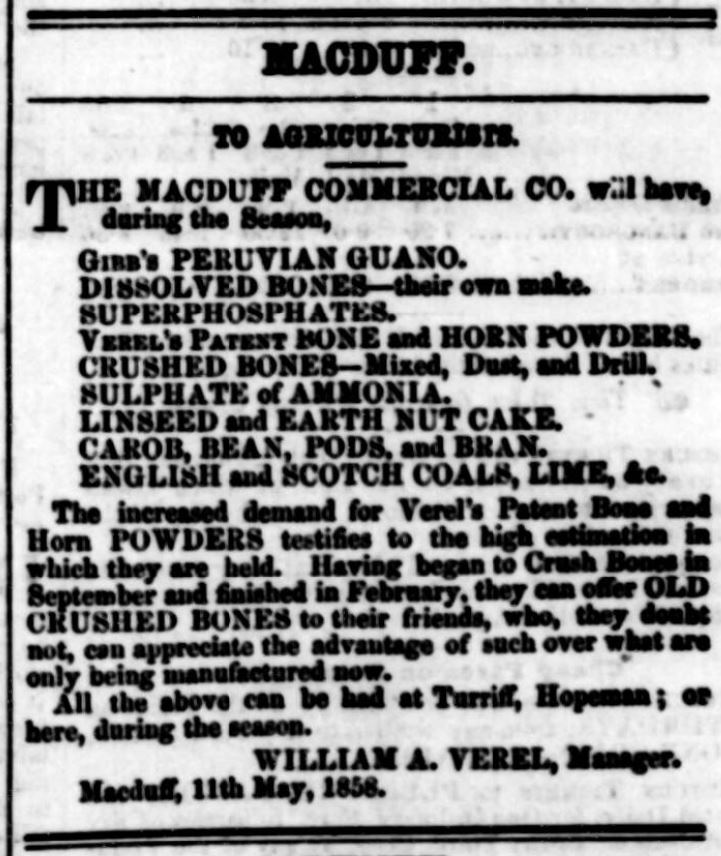
Advert for products of the MacDuff Commercial Company for agriculturists. William Vérel offers old crushed bones to his friends; charming! Bone meal was a then-new discovery as a livestock dietary supplement and as a fertiliser, so I presume (hope) his friends weren’t supposed to be taking his patent bone powders themselves. Source: Northern Advertiser 18 May 1858, BNA
Around 1866 William and his family moved to Glasgow, and took up residence at 35 (now 31) Regent Park Square. William had been appointed the general manager of the new Tharsis Sulphur and Copper Company, a Scottish consortium led by Charles Tennant to exploit the Tharsis pyrite mines in southern Spain, and which built a major narrow-gauge railway to the port of Huelva to service them (the line only closed in 1999). The sulphur was important for the production of sulphuric acid at the St Rollox works. The company also bought or founded several metal extraction works in Britain .
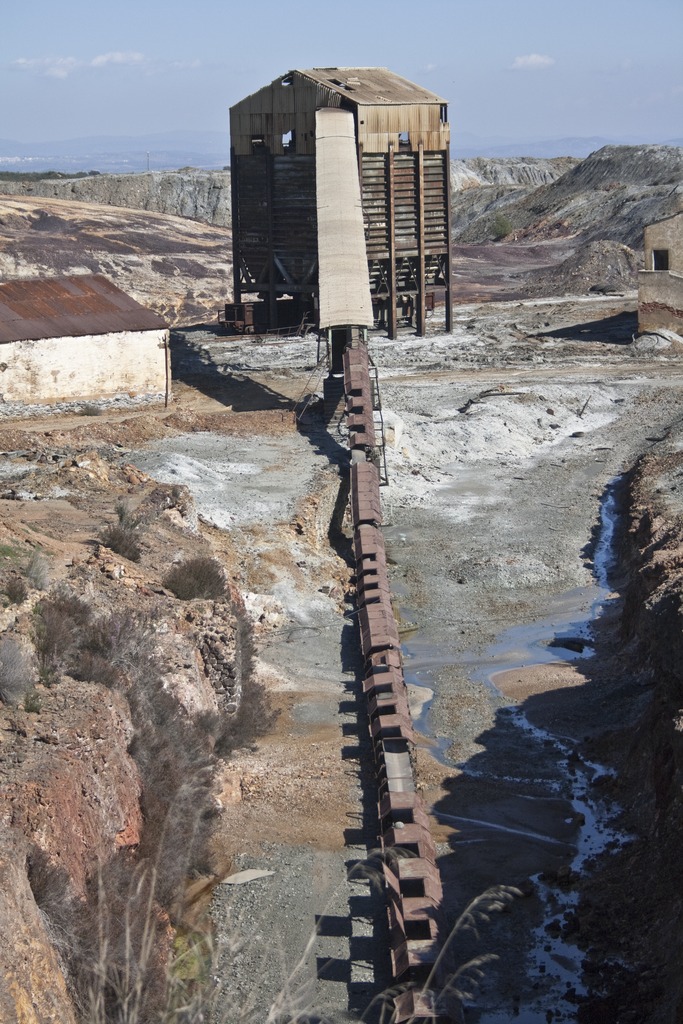
The remains of the Tharsis mine, Huelva, Spain. Source: iHeritage.eu
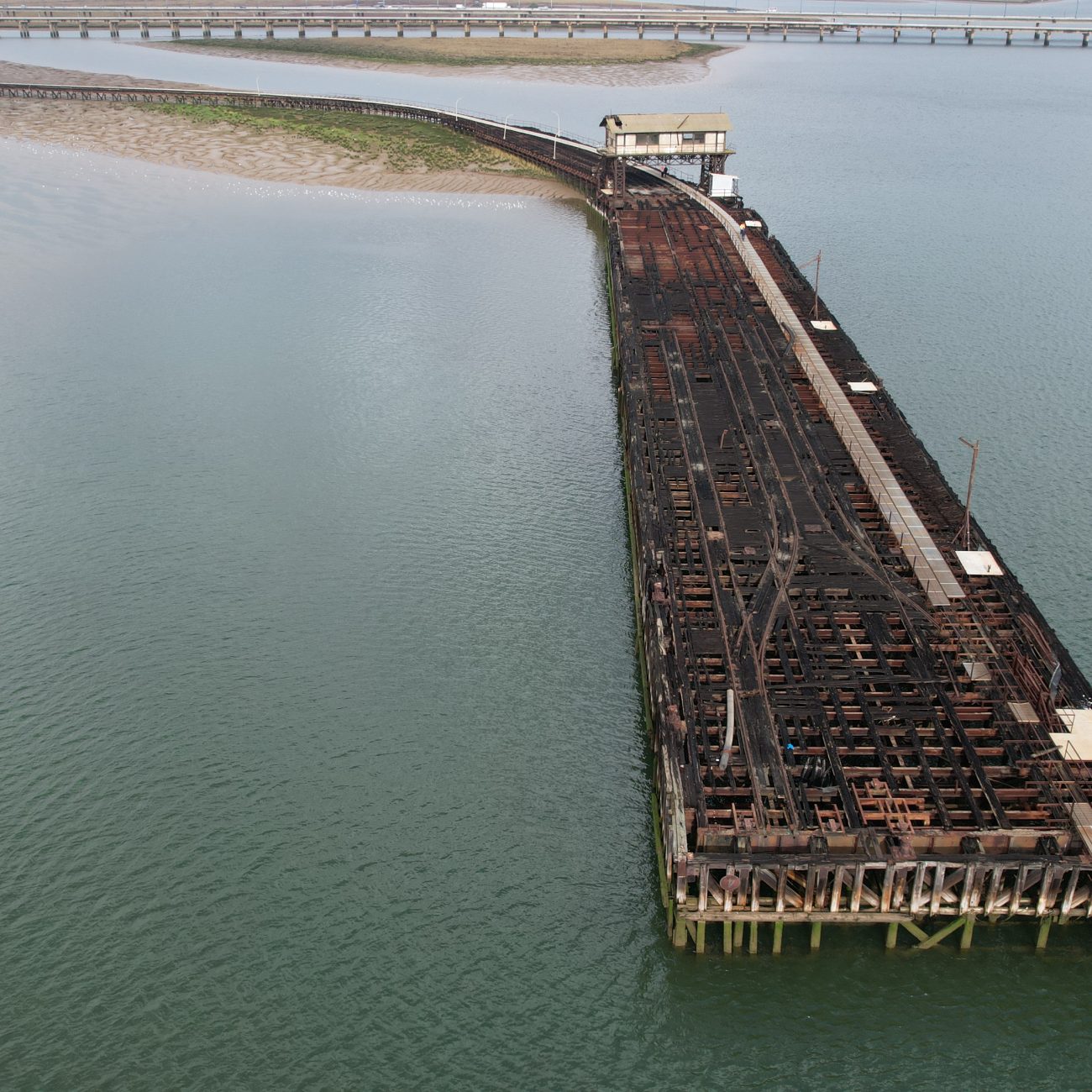
The terminus of the railway at Corrales was a long pier that allowed rapid loading of ships bound for Scotland. Source: ines.es
However around 1872 William moved to “The Linn”, a large mansion in Linn Park (now restored and converted to flats). He remained there until 1895 when he moved to Fairholm, Larkhall, where he died three years later. He left £85,000, a tidy sum. William had remained the manager of Tharsis for over 30 years. He had “exceptional business capacity, a retiring disposition and played no prominent part in public offices” and “was generous though not ostentatious”. He was an elder of Queen’s Park Free Church (now QP Parish Church) and a supporter of the Boys’ Brigade. .
My interest in the Vérels was partly piqued by a blog post on SGHET.com by Graeme Boyle, who first explored the history of chemistry in Cathcart, including the Tharsis Company .
Louisa Wright
Louisa Wright was the daughter of a farmer in Gamrie, Banffshire, who worked as a servant on a farm in Boyndie parish initially, but became the Vérel family servant in MacDuff (possibly in Gamrie). She served the family for the rest of her life, outliving both William and Ann. She was rewarded in his will with a £40 annuity .
The Vérel children
William & Ann’s daughter died in her early 20s while at The Linn. His sons Francis, John, Alphonso, Julian and William, who had grown up in Banffshire and Strathbungo, also became active in business.
Francis William Vérel
Francis trained as an analytical chemist (his occupation, aged 19, when in Strathbungo). He was also sporting – he turned out for Southern FC in a game reported in 1874. Ten years later at The Linn, the 1881 census noted he was a chemist to The Steel Company of Scotland. This was a firm established by Tennant in 1872 to explore the extraction of iron from the remaining Tharsis ore once the copper and sulphur had been removed. This residual ore (“Blue Billy”) had begun to pile up at St Rollox, and was about 75% iron oxide. Experiments conducted by William Siemens (of the famous German engineering family) suggested this waste could be turned into steel. Thus the firm was established and a works built at Hallside, Newton Station, to Siemens’ design, but the process proved too costly and was abandoned by 1875. Nonetheless the company continued steel production using Siemens’ open-hearth furnaces but more conventional sources of iron. The steel produced in this way was stronger than that produced by the rival Bessemer process, and it proved such a success that it launched the steel industry in Scotland; by the mid 1880s virtually all Clyde shipbuilding had switched from iron plate to open-hearth produced steel. The role of Hallside in the development of the Scottish steel and ship-building industry is thoroughly described at the Scottish Steelworks History website .
However Francis’ interest later turned from steel to photography. Back in 1862 Aberdeen James Skinner had become bored with his life as an accountant and began dabbling in the new field of photography, aided by luminaries such as George Washington Wilson. He quit his job, moved to Glasgow, and founded the Albion Albumenizing Company to manufacture photographic printing paper, coated in albumen (egg whites) soaked in light-sensitive silver halides. He was joined by George Donaldson Finlayson, and his son John Morrison Skinner. At that time photographers had to prepare their own photographic plates (negatives) in the field, expose them and develop and fix them all within 15 minutes using the wet collodion process, necessitating a portable darkroom. However they could then produce prints back at base using albumen-coated paper. Albion perfected the double albumenising technique, which is when sheets of paper treated with albumen are placed into a heating chamber where the steam softens the albumen surface. Next, the paper is prepared with salted albumen, which creates a glaze that produces superior prints. The firm flourished and branched out into selling chemicals, and building cameras. Finlayson left in 1887 and the Skinners continued alone.
Francis Vérel established a new works in Cathcart sometime before 1885, F W Vérel & Co, to make the newer gelatin dry plates in addition to photographic paper. Dry plates could be manufactured in advance, such as on glass, exposed as necessary, and developed later, greatly simplifying the production of a negative, and they rapidly replaced the wet collodion process for producing negatives. Around 1889 the firm also took over the Albion Albumenizing Company and Francis’ younger brother William Aristides Vérel Jnr was placed in charge of the Bath Street warehouse, darkroom, workshop and showroom. It’s not clear why the Skinners gave up the business, though they may have been good friends of the Vérels, as they too had lived in Aberdeen, Gamrie, MacDuff and Strathbungo. The Skinners later emigrated to New South Wales, Australia. After the takeover it would appear FW Vérel made the negatives in Cathcart, while Albion became a photographic dealership and camera manufacturer.
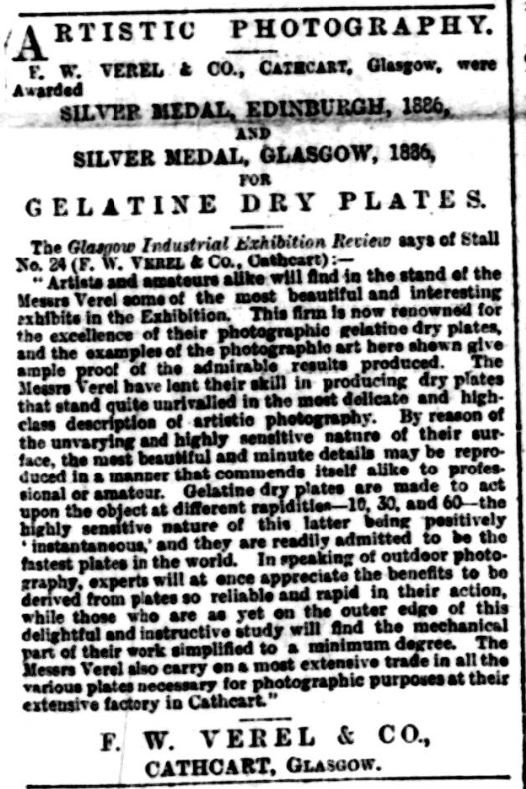
Advert for the merits of Vérel’s plates. Source: Evening Gazette (Aberdeen) – 6 Jan 1887, BNA
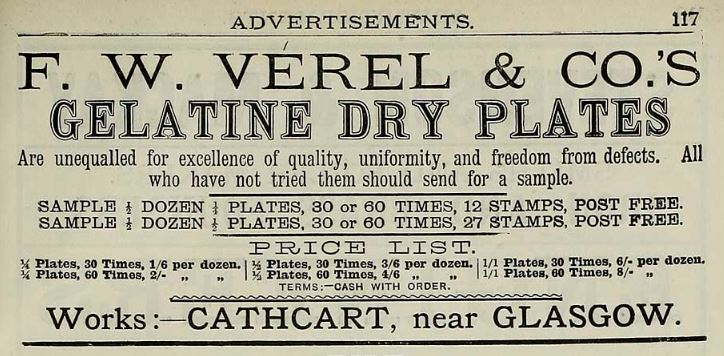
Advert for F W Vérel in Slater’s Directory of 1886. Source: NLS.
Francis died in 1914. The works had disappeared slightly earlier, overtaken by the expansion of the Weirs factory next door – present in 1910 but gone on a map of 1913.
William Aristides Vérel Jnr
In the 1881 census William, 19, was working as a ship broker’s clerk (perhaps for his brother John) and visiting a family in Rosneath that included his future wife, Naomi Wilson. They married in 1890, settled at Morar House, Langside Road (now Drive) and had three daughters. William lost his wife and then his mother within six weeks in 1908, but he lived to 85, dying in 1947. He was still running the Albion Company in Glasgow as late as 1930.
John Bisset Vérel
In 1873 William Raeburn founded a shipping company with a Capt Dunn, but in 1880 John Vérel replaced Capt Dunn to form Raeburn & Vérel. The company operated around 12 steamers to ports in America and the Far East. In 1902 Raeburn & Vérel formed the Monarch Steamship Company. Vérel retired in 1911 and Raeburn continued alone under the same trading name. He also became MP for Dunbartonshire, and later a Baronet . The firm closed in 1960. Amongst other cargoes, from 1878 they were regularly carrying sulphur ore from John’s father’s mines in Tharsis .
John married Minnie, had five children and lived in a villa in Langside, then in Ayrshire. In June 1897, the traditional time of year when new leases began, he rented Stenhouse Mansion near Larbert. His furniture was conveyed by rail from Kilwinning to Grahamston in 16 carriages along with his servants! He was the tenant for a number of years . After retirement he moved to Norwich where he died in 1927.
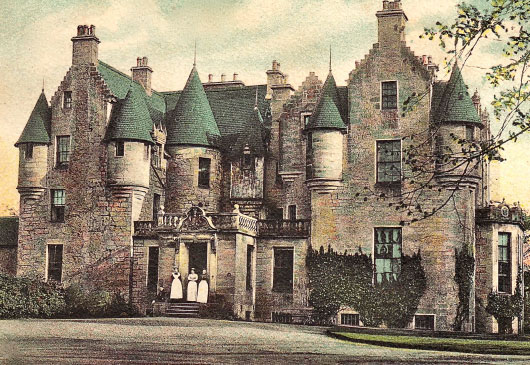
Stenhouse (Mansion or Castle), a 17th century manor house in Stenhousemuir, later rented by John Vérel. Eventually acquired by the adjacent Carron Ironworks, who allowed it to go to ruin. Demolished 1967. Source: Scottish Castles Association
Alphonso Anthony Vérel
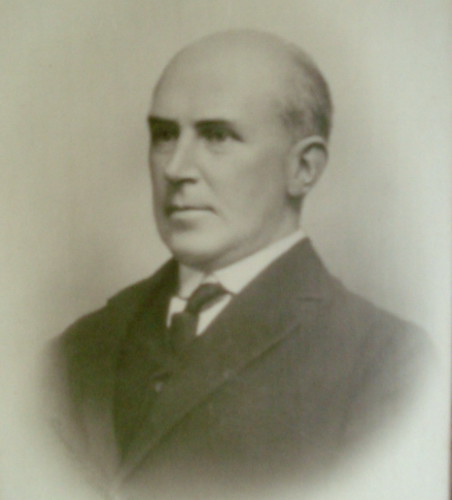
Alphonso Vérel. Source: ChristopherTW, Ancestry
Alphonso married Isabel Inglis Spence from Toronto and had five children, though two died in their teens. He initially worked for Henderson & Co, shipbrokers, for several years, but later became a partner in Vérel Brothers with his younger brother Julian. They were merchants dealing in oil, colour, india-rubber, and leather, and commission agents such as for James Carmichael & Co., Dundee, ironfounders and forgers, and The Line Throwing Gun Company of Dundee who had invented a device for firing life-saving lines to shipwrecks.
In 1905 the valuation roll showed Alphonso to be the owner of some 30 properties in Cathcart including many in and around Sinclair Drive. He died in 1911.
Isabella Vérel was left the sole partner in Vérel Brothers and sold it in 1920 .
Julian James Vérel
Julian also played football for Southern FC. He married fellow Strathbungo resident Emily Burgess Hay in 1880 and they initially lived with her mother at 18 (now 38) Queen Square, then at Mossgiel, Langside Road (now Drive). The couple appear to have had no children, and Emily died in 1901. Julian lived at a number of large properties, including The Peel, Carmunnock, and after his wife’s death he moved south, perhaps giving up the business, living in Morton Bagot Manor in Warwickshire in 1904 and Gorgate Hall in Norfolk in 1913. He died back in Scotland in 1947 at Johnstone.
In 1895 he was somehow involved in a New Zealand mining company with links to the Cassel Gold Extracting Company. The latter was an another offshoot of Tennant’s chemical business, which was effectively scammed by Mr Cassel and his fake gold extraction process, but later found an effective method for extracting gold, the MacArthur-Forrest process (see the SGHET.com blog post for more details, and my own post on One Moray Place which has links to the Forrests). However I couldn’t ascertain the nature of Julian’s involvement.
Mrs C Bladen
The PO Directory lists Mrs C Bladen as the occupier around 1872-77, but provides no other information about her. However The Scotsman reported how one Mrs B H Remmers had given birth to a son there on the 27th Sep 1874 . Mrs Bladen was presumably taking in lodgers, and we have met the infamous Mr Remmers before, lodging previously at 4 Moray Place. His is a fascinating story of invention, dodgy behaviour, fraud and ultimately flight from Scotland, so much so it has its own blog post.

Bernhard Heinrich Remmers
Hugh Morton
Hugh Morton was briefly resident around 1880-81, having spent many years in South Apsley Place in the Gorbals, and then moved swiftly on to Myrtle Park, Crosshill. Originally from Kilmarnock, he was a ham curer and wholesale provision merchant based in Shuttle Street. He was home alone in Regent Park Square (apart from his servant Maggie Lindsay) in the 1881 census; his wife Ellen and their three daughters were holidaying in Dunoon at the time.
James Hardie
James Hardie was a clerk and later a stockbroker at the stockbroking firm of James Watson & Smith’s. He was born in Linlithgow, but moved to Glasgow for his work. He married Mary Tough Gibbons in Linlithgow in 1864 and moved to Strathbungo, living in Elgin Place, and then 6 Regent Park Terrace. The couple had a daughter and a son, but then lost three young boys in succession, James at 3 months, Thomas at 3 years, and William at 4 months, before Mary herself died in 1877.
James and his two children then moved to 35 Regent Park Square from 1882 until James’ death in 1894, aged 58.
Hugh Buchan, Brassfounder
Hugh Buchan was born in 1826 in Cannongate, Edinburgh. He married Mary Dunn in Glasgow in 1851 and spent most of his subsequent years in Gloucester Street in Tradeston. He worked as a brassfounder with an office in Oswald Street. His son Alexander followed him in the business. In 1895 Hugh moved to 35 Regent Park Square and Alexander moved to Waverley Gardens. Hugh died in 1897 and his son took over the business. Hugh’s wife Mary lived on at no 35 until her death in 1906.
William Lochhead Rome
William was a bank clerk or agent for the City of Glasgow Bank until its spectacular collapse, and later the Union Bank of Scotland in Kinning Park. He lived in Keir Street, Pollokshields. He lost his first wife in 1884 and married again to Maggie Robertson. He moved to Strathbungo late in life, around 1906-10, and perhaps after his second wife’s death. He married a third time in 1912 to Christina Owens or Sinclair, and died at Regents Park Square in January 1917. His third wife lived on to at least 1939. I didn’t come across children from any of the marriages.
Additions and corrections welcome.
References
{3557955:C42S85XB};{3557955:AA8E4EFN};{3557955:DAD27LPW};{3557955:QH7N8IY9};{3557955:RUIB9N42};{3557955:L4NG4G56};{3557955:DAD27LPW};{3557955:QEAK92QP};{3557955:CVTEDS5Q},{3557955:GN44ASXC};{3557955:ZQXE8TLA};{3557955:G6KHWUBD};{3557955:6WXWTNMA};{3557955:8HMDSL9F}
vancouver
asc
0
5222
%7B%22status%22%3A%22success%22%2C%22updateneeded%22%3Afalse%2C%22instance%22%3A%22zotpress-53026ee17d2463cc0e62044d322773c0%22%2C%22meta%22%3A%7B%22request_last%22%3A0%2C%22request_next%22%3A0%2C%22used_cache%22%3Atrue%7D%2C%22data%22%3A%5B%7B%22key%22%3A%228HMDSL9F%22%2C%22library%22%3A%7B%22id%22%3A3557955%7D%2C%22meta%22%3A%7B%22parsedDate%22%3A%221874-09-29%22%2C%22numChildren%22%3A1%7D%2C%22bib%22%3A%22%3Cdiv%20class%3D%5C%22csl-bib-body%5C%22%20style%3D%5C%22line-height%3A%201.35%3B%20%5C%22%3E%5Cn%20%20%3Cdiv%20class%3D%5C%22csl-entry%5C%22%20style%3D%5C%22clear%3A%20left%3B%20%5C%22%3E%5Cn%20%20%20%20%3Cdiv%20class%3D%5C%22csl-left-margin%5C%22%20style%3D%5C%22float%3A%20left%3B%20padding-right%3A%200.5em%3B%20text-align%3A%20right%3B%20width%3A%201em%3B%5C%22%3E1.%3C%5C%2Fdiv%3E%3Cdiv%20class%3D%5C%22csl-right-inline%5C%22%20style%3D%5C%22margin%3A%200%20.4em%200%201.5em%3B%5C%22%3EBirths.%20The%20Scotsman%20%5BInternet%5D.%201874%20Sep%2029%20%5Bcited%202025%20May%2017%5D%3B%20Available%20from%3A%20%3Ca%20href%3D%27https%3A%5C%2F%5C%2Fwww.britishnewspaperarchive.co.uk%5C%2Fviewer%5C%2FBL%5C%2F0000540%5C%2F18740929%5C%2F194%5C%2F0008%3Fbrowse%3DFalse%27%3Ehttps%3A%5C%2F%5C%2Fwww.britishnewspaperarchive.co.uk%5C%2Fviewer%5C%2FBL%5C%2F0000540%5C%2F18740929%5C%2F194%5C%2F0008%3Fbrowse%3DFalse%3C%5C%2Fa%3E%3C%5C%2Fdiv%3E%5Cn%20%20%3C%5C%2Fdiv%3E%5Cn%3C%5C%2Fdiv%3E%22%2C%22data%22%3A%7B%22itemType%22%3A%22newspaperArticle%22%2C%22title%22%3A%22Births%22%2C%22creators%22%3A%5B%5D%2C%22abstractNote%22%3A%22%22%2C%22date%22%3A%2229%20Sep%201874%22%2C%22section%22%3A%22%22%2C%22language%22%3A%22%22%2C%22ISSN%22%3A%22%22%2C%22url%22%3A%22https%3A%5C%2F%5C%2Fwww.britishnewspaperarchive.co.uk%5C%2Fviewer%5C%2FBL%5C%2F0000540%5C%2F18740929%5C%2F194%5C%2F0008%3Fbrowse%3DFalse%22%2C%22collections%22%3A%5B%22CAR6MXPM%22%5D%2C%22dateModified%22%3A%222025-05-17T19%3A43%3A40Z%22%7D%7D%2C%7B%22key%22%3A%226WXWTNMA%22%2C%22library%22%3A%7B%22id%22%3A3557955%7D%2C%22meta%22%3A%7B%22parsedDate%22%3A%221920-03-23%22%2C%22numChildren%22%3A1%7D%2C%22bib%22%3A%22%3Cdiv%20class%3D%5C%22csl-bib-body%5C%22%20style%3D%5C%22line-height%3A%201.35%3B%20%5C%22%3E%5Cn%20%20%3Cdiv%20class%3D%5C%22csl-entry%5C%22%20style%3D%5C%22clear%3A%20left%3B%20%5C%22%3E%5Cn%20%20%20%20%3Cdiv%20class%3D%5C%22csl-left-margin%5C%22%20style%3D%5C%22float%3A%20left%3B%20padding-right%3A%200.5em%3B%20text-align%3A%20right%3B%20width%3A%201em%3B%5C%22%3E1.%3C%5C%2Fdiv%3E%3Cdiv%20class%3D%5C%22csl-right-inline%5C%22%20style%3D%5C%22margin%3A%200%20.4em%200%201.5em%3B%5C%22%3EThe%20Business%20of%20Verel%20Brothers.%20Edinburgh%20Gazette%20%5BInternet%5D.%201920%20Mar%2023%3B%20Available%20from%3A%20%3Ca%20href%3D%27https%3A%5C%2F%5C%2Fwww.thegazette.co.uk%5C%2FEdinburgh%5C%2Fissue%5C%2F13579%5C%2Fpage%5C%2F848%27%3Ehttps%3A%5C%2F%5C%2Fwww.thegazette.co.uk%5C%2FEdinburgh%5C%2Fissue%5C%2F13579%5C%2Fpage%5C%2F848%3C%5C%2Fa%3E%3C%5C%2Fdiv%3E%5Cn%20%20%3C%5C%2Fdiv%3E%5Cn%3C%5C%2Fdiv%3E%22%2C%22data%22%3A%7B%22itemType%22%3A%22journalArticle%22%2C%22title%22%3A%22The%20Business%20of%20Verel%20Brothers%22%2C%22creators%22%3A%5B%5D%2C%22abstractNote%22%3A%22%22%2C%22date%22%3A%2223%20Mar%201920%22%2C%22language%22%3A%22en%22%2C%22DOI%22%3A%22%22%2C%22ISSN%22%3A%22%22%2C%22url%22%3A%22https%3A%5C%2F%5C%2Fwww.thegazette.co.uk%5C%2FEdinburgh%5C%2Fissue%5C%2F13579%5C%2Fpage%5C%2F848%22%2C%22collections%22%3A%5B%22CAR6MXPM%22%5D%2C%22dateModified%22%3A%222025-05-17T19%3A43%3A01Z%22%7D%7D%2C%7B%22key%22%3A%22ZQXE8TLA%22%2C%22library%22%3A%7B%22id%22%3A3557955%7D%2C%22meta%22%3A%7B%22parsedDate%22%3A%221881-12-30%22%2C%22numChildren%22%3A1%7D%2C%22bib%22%3A%22%3Cdiv%20class%3D%5C%22csl-bib-body%5C%22%20style%3D%5C%22line-height%3A%201.35%3B%20%5C%22%3E%5Cn%20%20%3Cdiv%20class%3D%5C%22csl-entry%5C%22%20style%3D%5C%22clear%3A%20left%3B%20%5C%22%3E%5Cn%20%20%20%20%3Cdiv%20class%3D%5C%22csl-left-margin%5C%22%20style%3D%5C%22float%3A%20left%3B%20padding-right%3A%200.5em%3B%20text-align%3A%20right%3B%20width%3A%201em%3B%5C%22%3E1.%3C%5C%2Fdiv%3E%3Cdiv%20class%3D%5C%22csl-right-inline%5C%22%20style%3D%5C%22margin%3A%200%20.4em%200%201.5em%3B%5C%22%3EClyde%20Shipbuilding%20Trade%201881.%20The%20Scotsman%20%5BInternet%5D.%201881%20Dec%2030%20%5Bcited%202025%20May%2017%5D%3B%20Available%20from%3A%20%3Ca%20href%3D%27https%3A%5C%2F%5C%2Fwww.britishnewspaperarchive.co.uk%5C%2Fviewer%5C%2FBL%5C%2F0000540%5C%2F18811230%5C%2F144%5C%2F0006%3Fbrowse%3Dtrue%26fullscreen%3Dtrue%27%3Ehttps%3A%5C%2F%5C%2Fwww.britishnewspaperarchive.co.uk%5C%2Fviewer%5C%2FBL%5C%2F0000540%5C%2F18811230%5C%2F144%5C%2F0006%3Fbrowse%3Dtrue%26fullscreen%3Dtrue%3C%5C%2Fa%3E%3C%5C%2Fdiv%3E%5Cn%20%20%3C%5C%2Fdiv%3E%5Cn%3C%5C%2Fdiv%3E%22%2C%22data%22%3A%7B%22itemType%22%3A%22newspaperArticle%22%2C%22title%22%3A%22Clyde%20Shipbuilding%20Trade%201881%22%2C%22creators%22%3A%5B%5D%2C%22abstractNote%22%3A%22%22%2C%22date%22%3A%2230%20Dec%201881%22%2C%22section%22%3A%22%22%2C%22language%22%3A%22%22%2C%22ISSN%22%3A%22%22%2C%22url%22%3A%22https%3A%5C%2F%5C%2Fwww.britishnewspaperarchive.co.uk%5C%2Fviewer%5C%2FBL%5C%2F0000540%5C%2F18811230%5C%2F144%5C%2F0006%3Fbrowse%3Dtrue%26fullscreen%3Dtrue%22%2C%22collections%22%3A%5B%22CAR6MXPM%22%5D%2C%22dateModified%22%3A%222025-05-17T19%3A24%3A38Z%22%7D%7D%2C%7B%22key%22%3A%22AA8E4EFN%22%2C%22library%22%3A%7B%22id%22%3A3557955%7D%2C%22meta%22%3A%7B%22parsedDate%22%3A%221872-09-28%22%2C%22numChildren%22%3A1%7D%2C%22bib%22%3A%22%3Cdiv%20class%3D%5C%22csl-bib-body%5C%22%20style%3D%5C%22line-height%3A%201.35%3B%20%5C%22%3E%5Cn%20%20%3Cdiv%20class%3D%5C%22csl-entry%5C%22%20style%3D%5C%22clear%3A%20left%3B%20%5C%22%3E%5Cn%20%20%20%20%3Cdiv%20class%3D%5C%22csl-left-margin%5C%22%20style%3D%5C%22float%3A%20left%3B%20padding-right%3A%200.5em%3B%20text-align%3A%20right%3B%20width%3A%201em%3B%5C%22%3E1.%3C%5C%2Fdiv%3E%3Cdiv%20class%3D%5C%22csl-right-inline%5C%22%20style%3D%5C%22margin%3A%200%20.4em%200%201.5em%3B%5C%22%3ECircuit%20Court%20Of%20Justiciary.%20Glasgow%20Herald%20%5BInternet%5D.%201872%20Sep%2028%20%5Bcited%202025%20May%2017%5D%3B%20Available%20from%3A%20%3Ca%20href%3D%27https%3A%5C%2F%5C%2Fwww.britishnewspaperarchive.co.uk%5C%2Fviewer%5C%2Fbl%5C%2F0000060%5C%2F18720928%5C%2F012%5C%2F0004%27%3Ehttps%3A%5C%2F%5C%2Fwww.britishnewspaperarchive.co.uk%5C%2Fviewer%5C%2Fbl%5C%2F0000060%5C%2F18720928%5C%2F012%5C%2F0004%3C%5C%2Fa%3E%3C%5C%2Fdiv%3E%5Cn%20%20%3C%5C%2Fdiv%3E%5Cn%3C%5C%2Fdiv%3E%22%2C%22data%22%3A%7B%22itemType%22%3A%22newspaperArticle%22%2C%22title%22%3A%22Circuit%20Court%20Of%20Justiciary.%22%2C%22creators%22%3A%5B%5D%2C%22abstractNote%22%3A%22%22%2C%22date%22%3A%2228%20Sep%201872%22%2C%22section%22%3A%22%22%2C%22language%22%3A%22%22%2C%22ISSN%22%3A%22%22%2C%22url%22%3A%22https%3A%5C%2F%5C%2Fwww.britishnewspaperarchive.co.uk%5C%2Fviewer%5C%2Fbl%5C%2F0000060%5C%2F18720928%5C%2F012%5C%2F0004%22%2C%22collections%22%3A%5B%22CAR6MXPM%22%5D%2C%22dateModified%22%3A%222025-05-17T19%3A23%3A02Z%22%7D%7D%2C%7B%22key%22%3A%22C42S85XB%22%2C%22library%22%3A%7B%22id%22%3A3557955%7D%2C%22meta%22%3A%7B%22numChildren%22%3A0%7D%2C%22bib%22%3A%22%3Cdiv%20class%3D%5C%22csl-bib-body%5C%22%20style%3D%5C%22line-height%3A%201.35%3B%20%5C%22%3E%5Cn%20%20%3Cdiv%20class%3D%5C%22csl-entry%5C%22%20style%3D%5C%22clear%3A%20left%3B%20%5C%22%3E%5Cn%20%20%20%20%3Cdiv%20class%3D%5C%22csl-left-margin%5C%22%20style%3D%5C%22float%3A%20left%3B%20padding-right%3A%200.5em%3B%20text-align%3A%20right%3B%20width%3A%201em%3B%5C%22%3E1.%3C%5C%2Fdiv%3E%3Cdiv%20class%3D%5C%22csl-right-inline%5C%22%20style%3D%5C%22margin%3A%200%20.4em%200%201.5em%3B%5C%22%3EVintners%20%5BInternet%5D.%20%5Bcited%202025%20Mar%202%5D.%20Available%20from%3A%20%3Ca%20href%3D%27https%3A%5C%2F%5C%2Fwww.oldglasgowpubs.co.uk%5C%2Fvintners.html%27%3Ehttps%3A%5C%2F%5C%2Fwww.oldglasgowpubs.co.uk%5C%2Fvintners.html%3C%5C%2Fa%3E%3C%5C%2Fdiv%3E%5Cn%20%20%3C%5C%2Fdiv%3E%5Cn%3C%5C%2Fdiv%3E%22%2C%22data%22%3A%7B%22itemType%22%3A%22webpage%22%2C%22title%22%3A%22Vintners%22%2C%22creators%22%3A%5B%5D%2C%22abstractNote%22%3A%22%22%2C%22date%22%3A%22%22%2C%22url%22%3A%22https%3A%5C%2F%5C%2Fwww.oldglasgowpubs.co.uk%5C%2Fvintners.html%22%2C%22language%22%3A%22%22%2C%22collections%22%3A%5B%22CAR6MXPM%22%5D%2C%22dateModified%22%3A%222025-03-02T21%3A03%3A22Z%22%7D%7D%2C%7B%22key%22%3A%22L4NG4G56%22%2C%22library%22%3A%7B%22id%22%3A3557955%7D%2C%22meta%22%3A%7B%22numChildren%22%3A1%7D%2C%22bib%22%3A%22%3Cdiv%20class%3D%5C%22csl-bib-body%5C%22%20style%3D%5C%22line-height%3A%201.35%3B%20%5C%22%3E%5Cn%20%20%3Cdiv%20class%3D%5C%22csl-entry%5C%22%20style%3D%5C%22clear%3A%20left%3B%20%5C%22%3E%5Cn%20%20%20%20%3Cdiv%20class%3D%5C%22csl-left-margin%5C%22%20style%3D%5C%22float%3A%20left%3B%20padding-right%3A%200.5em%3B%20text-align%3A%20right%3B%20width%3A%201em%3B%5C%22%3E1.%3C%5C%2Fdiv%3E%3Cdiv%20class%3D%5C%22csl-right-inline%5C%22%20style%3D%5C%22margin%3A%200%20.4em%200%201.5em%3B%5C%22%3EGas%2C%20Petrol%20and%20Alchemy%20in%20Cathcart%20%5BInternet%5D.%20SGHET.%20%5Bcited%202025%20Feb%2023%5D.%20Available%20from%3A%20%3Ca%20href%3D%27https%3A%5C%2F%5C%2Fsghet.com%5C%2Fproject%5C%2Fgas-petrol-and-alchemy-in-cathcart-glasgow%5C%2F%27%3Ehttps%3A%5C%2F%5C%2Fsghet.com%5C%2Fproject%5C%2Fgas-petrol-and-alchemy-in-cathcart-glasgow%5C%2F%3C%5C%2Fa%3E%3C%5C%2Fdiv%3E%5Cn%20%20%3C%5C%2Fdiv%3E%5Cn%3C%5C%2Fdiv%3E%22%2C%22data%22%3A%7B%22itemType%22%3A%22blogPost%22%2C%22title%22%3A%22Gas%2C%20Petrol%20and%20Alchemy%20in%20Cathcart%22%2C%22creators%22%3A%5B%5D%2C%22abstractNote%22%3A%22Exploring%20an%20odd%20reference%20to%20a%20gold%20extracting%20firm%20in%20Glasgow%27s%20Cathcart%20suburb%2C%20uncovers%20a%20story%20of%20bold%20Victorian%20engineering%20and%20entrepreneurial%20verve.%22%2C%22blogTitle%22%3A%22SGHET%22%2C%22date%22%3A%22%22%2C%22url%22%3A%22https%3A%5C%2F%5C%2Fsghet.com%5C%2Fproject%5C%2Fgas-petrol-and-alchemy-in-cathcart-glasgow%5C%2F%22%2C%22language%22%3A%22en-US%22%2C%22collections%22%3A%5B%22CAR6MXPM%22%5D%2C%22dateModified%22%3A%222025-02-23T20%3A14%3A23Z%22%7D%7D%2C%7B%22key%22%3A%22QEAK92QP%22%2C%22library%22%3A%7B%22id%22%3A3557955%7D%2C%22meta%22%3A%7B%22numChildren%22%3A1%7D%2C%22bib%22%3A%22%3Cdiv%20class%3D%5C%22csl-bib-body%5C%22%20style%3D%5C%22line-height%3A%201.35%3B%20%5C%22%3E%5Cn%20%20%3Cdiv%20class%3D%5C%22csl-entry%5C%22%20style%3D%5C%22clear%3A%20left%3B%20%5C%22%3E%5Cn%20%20%20%20%3Cdiv%20class%3D%5C%22csl-left-margin%5C%22%20style%3D%5C%22float%3A%20left%3B%20padding-right%3A%200.5em%3B%20text-align%3A%20right%3B%20width%3A%201em%3B%5C%22%3E1.%3C%5C%2Fdiv%3E%3Cdiv%20class%3D%5C%22csl-right-inline%5C%22%20style%3D%5C%22margin%3A%200%20.4em%200%201.5em%3B%5C%22%3EClydebridge%20%5BInternet%5D.%20%5Bcited%202025%20Feb%2022%5D.%20Hallside.%20Available%20from%3A%20%3Ca%20href%3D%27https%3A%5C%2F%5C%2Fcfindlay17.wixsite.com%5C%2Fclydebridge%5C%2Fhallside-1%27%3Ehttps%3A%5C%2F%5C%2Fcfindlay17.wixsite.com%5C%2Fclydebridge%5C%2Fhallside-1%3C%5C%2Fa%3E%3C%5C%2Fdiv%3E%5Cn%20%20%3C%5C%2Fdiv%3E%5Cn%3C%5C%2Fdiv%3E%22%2C%22data%22%3A%7B%22itemType%22%3A%22webpage%22%2C%22title%22%3A%22Hallside%22%2C%22creators%22%3A%5B%5D%2C%22abstractNote%22%3A%22%22%2C%22date%22%3A%22%22%2C%22url%22%3A%22https%3A%5C%2F%5C%2Fcfindlay17.wixsite.com%5C%2Fclydebridge%5C%2Fhallside-1%22%2C%22language%22%3A%22en%22%2C%22collections%22%3A%5B%22CAR6MXPM%22%5D%2C%22dateModified%22%3A%222025-02-22T13%3A41%3A37Z%22%7D%7D%2C%7B%22key%22%3A%22DAD27LPW%22%2C%22library%22%3A%7B%22id%22%3A3557955%7D%2C%22meta%22%3A%7B%22numChildren%22%3A1%7D%2C%22bib%22%3A%22%3Cdiv%20class%3D%5C%22csl-bib-body%5C%22%20style%3D%5C%22line-height%3A%201.35%3B%20%5C%22%3E%5Cn%20%20%3Cdiv%20class%3D%5C%22csl-entry%5C%22%20style%3D%5C%22clear%3A%20left%3B%20%5C%22%3E%5Cn%20%20%20%20%3Cdiv%20class%3D%5C%22csl-left-margin%5C%22%20style%3D%5C%22float%3A%20left%3B%20padding-right%3A%200.5em%3B%20text-align%3A%20right%3B%20width%3A%201em%3B%5C%22%3E1.%3C%5C%2Fdiv%3E%3Cdiv%20class%3D%5C%22csl-right-inline%5C%22%20style%3D%5C%22margin%3A%200%20.4em%200%201.5em%3B%5C%22%3EWilliam%20Aristides%20Verel%20%281824-1898%29%20-%20Find%20a...%20%5BInternet%5D.%20%5Bcited%202025%20Feb%2021%5D.%20Available%20from%3A%20%3Ca%20href%3D%27https%3A%5C%2F%5C%2Fwww.findagrave.com%5C%2Fmemorial%5C%2F214956616%5C%2Fwilliam_aristides-verel%27%3Ehttps%3A%5C%2F%5C%2Fwww.findagrave.com%5C%2Fmemorial%5C%2F214956616%5C%2Fwilliam_aristides-verel%3C%5C%2Fa%3E%3C%5C%2Fdiv%3E%5Cn%20%20%3C%5C%2Fdiv%3E%5Cn%3C%5C%2Fdiv%3E%22%2C%22data%22%3A%7B%22itemType%22%3A%22webpage%22%2C%22title%22%3A%22William%20Aristides%20Verel%20%281824-1898%29%20-%20Find%20a...%22%2C%22creators%22%3A%5B%5D%2C%22abstractNote%22%3A%22William%20died%20at%20home%20Fairholm%20Larkhall%20where%20he%20moved%203%20years%20previously%20and%20as%20a%20result%20of%20cadiac%20dilations%2C%20mitral%20disease%20of%20the%20heart.%20His%20probate%20was%20%5Cu00a385%2C766-11-8%20and%20debts%20of%20%5Cu00a32%2C877-10-10.%20He%20had%20numerous%20policies%20and%20shares%20in%20lots%20of%20Companies%20in%20the%20UK%20and%20abroad.%20His%20wife%20declined%20to%20be%20an%20executor%2C%20she%20was%20...%22%2C%22date%22%3A%22%22%2C%22url%22%3A%22https%3A%5C%2F%5C%2Fwww.findagrave.com%5C%2Fmemorial%5C%2F214956616%5C%2Fwilliam_aristides-verel%22%2C%22language%22%3A%22en%22%2C%22collections%22%3A%5B%22CAR6MXPM%22%5D%2C%22dateModified%22%3A%222025-02-21T23%3A32%3A43Z%22%7D%7D%2C%7B%22key%22%3A%22QH7N8IY9%22%2C%22library%22%3A%7B%22id%22%3A3557955%7D%2C%22meta%22%3A%7B%22numChildren%22%3A1%7D%2C%22bib%22%3A%22%3Cdiv%20class%3D%5C%22csl-bib-body%5C%22%20style%3D%5C%22line-height%3A%201.35%3B%20%5C%22%3E%5Cn%20%20%3Cdiv%20class%3D%5C%22csl-entry%5C%22%20style%3D%5C%22clear%3A%20left%3B%20%5C%22%3E%5Cn%20%20%20%20%3Cdiv%20class%3D%5C%22csl-left-margin%5C%22%20style%3D%5C%22float%3A%20left%3B%20padding-right%3A%200.5em%3B%20text-align%3A%20right%3B%20width%3A%201em%3B%5C%22%3E1.%3C%5C%2Fdiv%3E%3Cdiv%20class%3D%5C%22csl-right-inline%5C%22%20style%3D%5C%22margin%3A%200%20.4em%200%201.5em%3B%5C%22%3ERecords%20of%20Tharsis%20Sulphur%20%26amp%3B%20Copper%20Co%20Ltd%2C%20miners%20and%20chemical%20engineers%2C%20Glasgow%2C%20Scotland%20-%20Archives%20Hub%20%5BInternet%5D.%20%5Bcited%202025%20Feb%2021%5D.%20Available%20from%3A%20%3Ca%20href%3D%27http%3A%5C%2F%5C%2Farchiveshub.jisc.ac.uk%5C%2Fdata%5C%2Fgb248-ugd057%27%3Ehttp%3A%5C%2F%5C%2Farchiveshub.jisc.ac.uk%5C%2Fdata%5C%2Fgb248-ugd057%3C%5C%2Fa%3E%3C%5C%2Fdiv%3E%5Cn%20%20%3C%5C%2Fdiv%3E%5Cn%3C%5C%2Fdiv%3E%22%2C%22data%22%3A%7B%22itemType%22%3A%22webpage%22%2C%22title%22%3A%22Records%20of%20Tharsis%20Sulphur%20%26%20Copper%20Co%20Ltd%2C%20miners%20and%20chemical%20engineers%2C%20Glasgow%2C%20Scotland%20-%20Archives%20Hub%22%2C%22creators%22%3A%5B%5D%2C%22abstractNote%22%3A%22%22%2C%22date%22%3A%22%22%2C%22url%22%3A%22http%3A%5C%2F%5C%2Farchiveshub.jisc.ac.uk%5C%2Fdata%5C%2Fgb248-ugd057%22%2C%22language%22%3A%22%22%2C%22collections%22%3A%5B%22CAR6MXPM%22%5D%2C%22dateModified%22%3A%222025-02-21T23%3A16%3A09Z%22%7D%7D%2C%7B%22key%22%3A%22RUIB9N42%22%2C%22library%22%3A%7B%22id%22%3A3557955%7D%2C%22meta%22%3A%7B%22parsedDate%22%3A%221898-09-14%22%2C%22numChildren%22%3A1%7D%2C%22bib%22%3A%22%3Cdiv%20class%3D%5C%22csl-bib-body%5C%22%20style%3D%5C%22line-height%3A%201.35%3B%20%5C%22%3E%5Cn%20%20%3Cdiv%20class%3D%5C%22csl-entry%5C%22%20style%3D%5C%22clear%3A%20left%3B%20%5C%22%3E%5Cn%20%20%20%20%3Cdiv%20class%3D%5C%22csl-left-margin%5C%22%20style%3D%5C%22float%3A%20left%3B%20padding-right%3A%200.5em%3B%20text-align%3A%20right%3B%20width%3A%201em%3B%5C%22%3E1.%3C%5C%2Fdiv%3E%3Cdiv%20class%3D%5C%22csl-right-inline%5C%22%20style%3D%5C%22margin%3A%200%20.4em%200%201.5em%3B%5C%22%3EDeath%20of%20Manager%20of%20Tharsis%20Copper%20Company.%20Aberdeen%20Press%20and%20Journal%20%5BInternet%5D.%201898%20Sep%2014%20%5Bcited%202025%20Feb%2021%5D%3B%20Available%20from%3A%20%3Ca%20href%3D%27https%3A%5C%2F%5C%2Fwww.britishnewspaperarchive.co.uk%5C%2Fviewer%5C%2Fbl%5C%2F0000032%5C%2F18980914%5C%2F037%5C%2F0007%27%3Ehttps%3A%5C%2F%5C%2Fwww.britishnewspaperarchive.co.uk%5C%2Fviewer%5C%2Fbl%5C%2F0000032%5C%2F18980914%5C%2F037%5C%2F0007%3C%5C%2Fa%3E%3C%5C%2Fdiv%3E%5Cn%20%20%3C%5C%2Fdiv%3E%5Cn%3C%5C%2Fdiv%3E%22%2C%22data%22%3A%7B%22itemType%22%3A%22newspaperArticle%22%2C%22title%22%3A%22Death%20of%20Manager%20of%20Tharsis%20Copper%20Company%22%2C%22creators%22%3A%5B%5D%2C%22abstractNote%22%3A%22%22%2C%22date%22%3A%2214%20September%201898%22%2C%22section%22%3A%22%22%2C%22language%22%3A%22%22%2C%22ISSN%22%3A%22%22%2C%22url%22%3A%22https%3A%5C%2F%5C%2Fwww.britishnewspaperarchive.co.uk%5C%2Fviewer%5C%2Fbl%5C%2F0000032%5C%2F18980914%5C%2F037%5C%2F0007%22%2C%22collections%22%3A%5B%22CAR6MXPM%22%5D%2C%22dateModified%22%3A%222025-02-21T22%3A53%3A37Z%22%7D%7D%2C%7B%22key%22%3A%22G6KHWUBD%22%2C%22library%22%3A%7B%22id%22%3A3557955%7D%2C%22meta%22%3A%7B%22parsedDate%22%3A%222020-04-10%22%2C%22numChildren%22%3A1%7D%2C%22bib%22%3A%22%3Cdiv%20class%3D%5C%22csl-bib-body%5C%22%20style%3D%5C%22line-height%3A%201.35%3B%20%5C%22%3E%5Cn%20%20%3Cdiv%20class%3D%5C%22csl-entry%5C%22%20style%3D%5C%22clear%3A%20left%3B%20%5C%22%3E%5Cn%20%20%20%20%3Cdiv%20class%3D%5C%22csl-left-margin%5C%22%20style%3D%5C%22float%3A%20left%3B%20padding-right%3A%200.5em%3B%20text-align%3A%20right%3B%20width%3A%201em%3B%5C%22%3E1.%3C%5C%2Fdiv%3E%3Cdiv%20class%3D%5C%22csl-right-inline%5C%22%20style%3D%5C%22margin%3A%200%20.4em%200%201.5em%3B%5C%22%3EStenhouse%20%5BInternet%5D.%20Falkirk%20Local%20History%20Society.%202020%20%5Bcited%202025%20Feb%2020%5D.%20Available%20from%3A%20%3Ca%20href%3D%27https%3A%5C%2F%5C%2Ffalkirklocalhistory.club%5C%2Faround-the-area%5C%2Fhouses-and-estates%5C%2Fstenhouse-2-2%5C%2F%27%3Ehttps%3A%5C%2F%5C%2Ffalkirklocalhistory.club%5C%2Faround-the-area%5C%2Fhouses-and-estates%5C%2Fstenhouse-2-2%5C%2F%3C%5C%2Fa%3E%3C%5C%2Fdiv%3E%5Cn%20%20%3C%5C%2Fdiv%3E%5Cn%3C%5C%2Fdiv%3E%22%2C%22data%22%3A%7B%22itemType%22%3A%22blogPost%22%2C%22title%22%3A%22Stenhouse%22%2C%22creators%22%3A%5B%5D%2C%22abstractNote%22%3A%22The%20Lands%20of%20Stenhouse%20came%20into%20the%20ownership%20of%20the%20Bruces%20of%20Airth%20in%201451%20and%20became%20a%20separate%20cadet%20branch%20of%20the%20family%20in%20the%20early%20seventeenth%20century%20when%20Sir%20William%20Bruce%20was%20in%20possess%5Cu2026%22%2C%22blogTitle%22%3A%22Falkirk%20Local%20History%20Society%22%2C%22date%22%3A%222020-04-10T11%3A39%3A12%2B00%3A00%22%2C%22url%22%3A%22https%3A%5C%2F%5C%2Ffalkirklocalhistory.club%5C%2Faround-the-area%5C%2Fhouses-and-estates%5C%2Fstenhouse-2-2%5C%2F%22%2C%22language%22%3A%22en%22%2C%22collections%22%3A%5B%22CAR6MXPM%22%5D%2C%22dateModified%22%3A%222025-02-20T18%3A58%3A22Z%22%7D%7D%2C%7B%22key%22%3A%22CVTEDS5Q%22%2C%22library%22%3A%7B%22id%22%3A3557955%7D%2C%22meta%22%3A%7B%22parsedDate%22%3A%221911-04-04%22%2C%22numChildren%22%3A1%7D%2C%22bib%22%3A%22%3Cdiv%20class%3D%5C%22csl-bib-body%5C%22%20style%3D%5C%22line-height%3A%201.35%3B%20%5C%22%3E%5Cn%20%20%3Cdiv%20class%3D%5C%22csl-entry%5C%22%20style%3D%5C%22clear%3A%20left%3B%20%5C%22%3E%5Cn%20%20%20%20%3Cdiv%20class%3D%5C%22csl-left-margin%5C%22%20style%3D%5C%22float%3A%20left%3B%20padding-right%3A%200.5em%3B%20text-align%3A%20right%3B%20width%3A%201em%3B%5C%22%3E1.%3C%5C%2Fdiv%3E%3Cdiv%20class%3D%5C%22csl-right-inline%5C%22%20style%3D%5C%22margin%3A%200%20.4em%200%201.5em%3B%5C%22%3ERaeburn%20%26amp%3B%20V%26%23xE9%3Brel.%20The%20Edinburgh%20Gazette%20%5BInternet%5D.%201911%20Apr%204%20%5Bcited%202025%20Feb%2020%5D%3B%20Available%20from%3A%20%3Ca%20href%3D%27https%3A%5C%2F%5C%2Fwww.thegazette.co.uk%5C%2FEdinburgh%5C%2Fissue%5C%2F12343%5C%2Fpage%5C%2F358%5C%2Fdata.pdf%23view%3DFit%26toolbar%3D1%27%3Ehttps%3A%5C%2F%5C%2Fwww.thegazette.co.uk%5C%2FEdinburgh%5C%2Fissue%5C%2F12343%5C%2Fpage%5C%2F358%5C%2Fdata.pdf%23view%3DFit%26toolbar%3D1%3C%5C%2Fa%3E%3C%5C%2Fdiv%3E%5Cn%20%20%3C%5C%2Fdiv%3E%5Cn%3C%5C%2Fdiv%3E%22%2C%22data%22%3A%7B%22itemType%22%3A%22newspaperArticle%22%2C%22title%22%3A%22Raeburn%20%26%20V%5Cu00e9rel%22%2C%22creators%22%3A%5B%5D%2C%22abstractNote%22%3A%22%22%2C%22date%22%3A%224%20Apr%201911%22%2C%22section%22%3A%22%22%2C%22language%22%3A%22%22%2C%22ISSN%22%3A%22%22%2C%22url%22%3A%22https%3A%5C%2F%5C%2Fwww.thegazette.co.uk%5C%2FEdinburgh%5C%2Fissue%5C%2F12343%5C%2Fpage%5C%2F358%5C%2Fdata.pdf%23view%3DFit%26toolbar%3D1%22%2C%22collections%22%3A%5B%22CAR6MXPM%22%5D%2C%22dateModified%22%3A%222025-02-20T18%3A37%3A17Z%22%7D%7D%2C%7B%22key%22%3A%22GN44ASXC%22%2C%22library%22%3A%7B%22id%22%3A3557955%7D%2C%22meta%22%3A%7B%22parsedDate%22%3A%222023-11-06%22%2C%22numChildren%22%3A1%7D%2C%22bib%22%3A%22%3Cdiv%20class%3D%5C%22csl-bib-body%5C%22%20style%3D%5C%22line-height%3A%201.35%3B%20%5C%22%3E%5Cn%20%20%3Cdiv%20class%3D%5C%22csl-entry%5C%22%20style%3D%5C%22clear%3A%20left%3B%20%5C%22%3E%5Cn%20%20%20%20%3Cdiv%20class%3D%5C%22csl-left-margin%5C%22%20style%3D%5C%22float%3A%20left%3B%20padding-right%3A%200.5em%3B%20text-align%3A%20right%3B%20width%3A%201em%3B%5C%22%3E1.%3C%5C%2Fdiv%3E%3Cdiv%20class%3D%5C%22csl-right-inline%5C%22%20style%3D%5C%22margin%3A%200%20.4em%200%201.5em%3B%5C%22%3EWilliam%20Raeburn.%20In%3A%20Wikipedia%20%5BInternet%5D.%202023%20%5Bcited%202025%20Feb%2020%5D.%20Available%20from%3A%20%3Ca%20href%3D%27https%3A%5C%2F%5C%2Fen.wikipedia.org%5C%2Fw%5C%2Findex.php%3Ftitle%3DWilliam_Raeburn%26oldid%3D1183848042%27%3Ehttps%3A%5C%2F%5C%2Fen.wikipedia.org%5C%2Fw%5C%2Findex.php%3Ftitle%3DWilliam_Raeburn%26oldid%3D1183848042%3C%5C%2Fa%3E%3C%5C%2Fdiv%3E%5Cn%20%20%3C%5C%2Fdiv%3E%5Cn%3C%5C%2Fdiv%3E%22%2C%22data%22%3A%7B%22itemType%22%3A%22encyclopediaArticle%22%2C%22title%22%3A%22William%20Raeburn%22%2C%22creators%22%3A%5B%5D%2C%22abstractNote%22%3A%22Sir%20William%20Hannay%20Raeburn%2C%201st%20Baronet%20%2811%20August%201850%20%5Cu2013%2012%20February%201934%29%20was%20a%20Scottish%20shipping%20businessman%20and%20Unionist%20Party%20politician%20who%20served%20as%20a%20member%20of%20parliament%20%28MP%29%20between%201918%20and%201923.%5CnRaeburn%20was%20a%20shipping%20magnate%20who%20founded%20in%201873%20a%20shipping%20company%20called%20Raeburn%20%26%20Dunn%2C%20with%20Captain%20Dunn.%20John%20Verel%20replaced%20Dunn%20in%201880%20and%20the%20company%20was%20subsequently%20renamed%20Raeburn%20%26%20Verel.%20By%201900%20the%20company%20operated%20around%2012%20steamers%2C%20travelling%20to%20ports%20from%20Europe%20to%20America%20and%20the%20Far%20East.%20In%201902%20Raeburn%20and%20Verel%20formed%20the%20Monarch%20Steamship%20Company%20Ltd.%20%20Raeburn%20was%20an%20important%20figure%20in%20the%20shipping%20industry%20in%20the%20West%20of%20Scotland%20and%20contributed%20to%20some%20of%20the%20shipping%20legislation%20which%20passed%2C%20including%20the%20Merchant%20Shipping%20Act%20and%20the%20Workmen%27s%20Compensation%20Act%201906.%20He%20came%20to%20live%20in%20Helensburgh%20towards%20the%20end%20of%20the%2019th%20century%2C%20and%20his%20obituary%20in%20the%20Helensburgh%20%26%20Gareloch%20Times%20describes%20how%20he%20was%20involved%20in%20various%20aspects%20of%20the%20shipping%20industry%20and%20how%20%5C%22in%201916%20he%20was%20appointed%20President%20of%20the%20Chamber%20of%20Shipping%20by%20the%20shipowners%20of%20the%20United%20Kingdom%5C%22.%20On%20his%20retirement%20from%20that%20post%20he%20was%20awarded%20with%20a%20knighthood.%5CnAt%20the%201918%20general%20election%2C%20Raeburn%20was%20nominated%20as%20the%20Unionist%20Party%20candidate%20for%20the%20Dunbartonshire.%20He%20received%20the%20%5C%22coalition%20coupon%5C%22%20and%20as%20a%20%5C%22Coalition%20Unionist%5C%22%20he%20overwhelmingly%20defeated%20the%20sitting%20Liberal%20Party%20MP%20Arthur%20Acland%20Allen%20%28who%20won%20a%20meagre%2013%25%20of%20the%20votes%29.%20Raeburn%20was%20re-elected%20in%201922%20general%20election%20with%20a%20majority%20of%20only%200.8%20percent%20over%20his%20sole%20opponent%2C%20the%20Labour%20Party%20candidate%20William%20Martin.%20%20He%20did%20not%20contest%20the%201923%20general%20election%2C%20when%20Martin%20won%20the%20seat%2C%20and%20did%20not%20stand%20for%20Parliament%20again.%5CnOn%2029%20June%201923%2C%20he%20was%20made%20a%20baronet%2C%20of%20Helensburgh.%22%2C%22encyclopediaTitle%22%3A%22Wikipedia%22%2C%22date%22%3A%222023-11-06T21%3A40%3A32Z%22%2C%22ISBN%22%3A%22%22%2C%22url%22%3A%22https%3A%5C%2F%5C%2Fen.wikipedia.org%5C%2Fw%5C%2Findex.php%3Ftitle%3DWilliam_Raeburn%26oldid%3D1183848042%22%2C%22language%22%3A%22en%22%2C%22collections%22%3A%5B%22CAR6MXPM%22%5D%2C%22dateModified%22%3A%222025-02-20T11%3A55%3A10Z%22%7D%7D%5D%7D
Like this:
Like Loading...





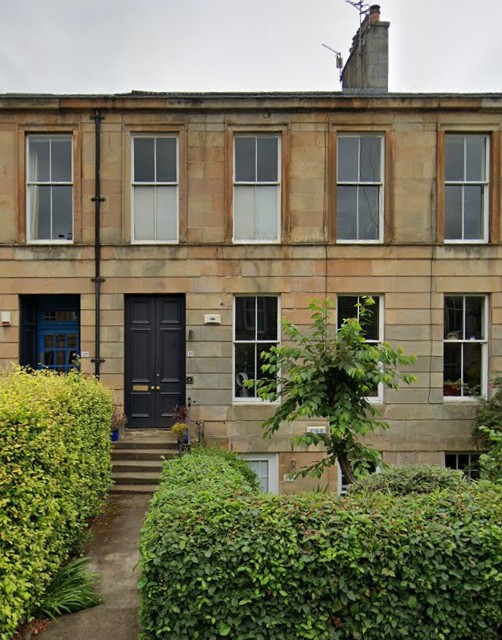






Leave a Reply